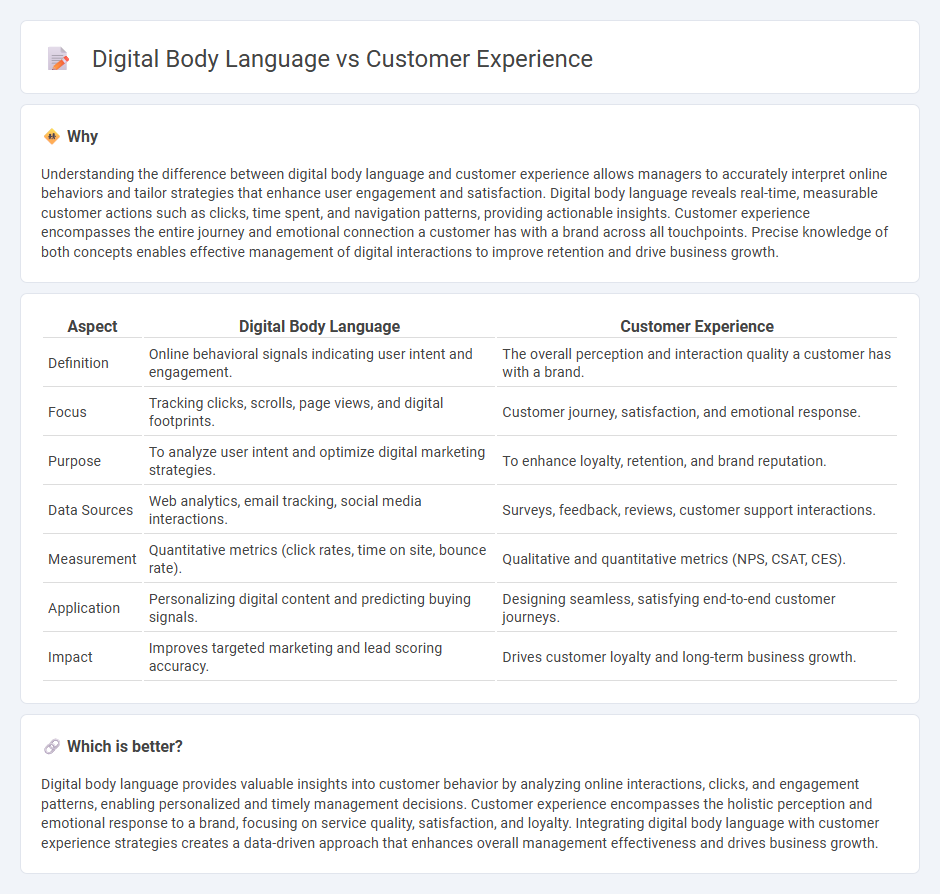
Digital body language encompasses the online behaviors and interactions customers exhibit, providing critical insights into their preferences and engagement levels. Understanding these patterns enhances customer experience by enabling personalized communication and timely support tailored to individual needs. Explore how leveraging digital body language can transform your management strategies and elevate customer satisfaction.
Why it is important
Understanding the difference between digital body language and customer experience allows managers to accurately interpret online behaviors and tailor strategies that enhance user engagement and satisfaction. Digital body language reveals real-time, measurable customer actions such as clicks, time spent, and navigation patterns, providing actionable insights. Customer experience encompasses the entire journey and emotional connection a customer has with a brand across all touchpoints. Precise knowledge of both concepts enables effective management of digital interactions to improve retention and drive business growth.
Comparison Table
| Aspect | Digital Body Language | Customer Experience |
|---|---|---|
| Definition | Online behavioral signals indicating user intent and engagement. | The overall perception and interaction quality a customer has with a brand. |
| Focus | Tracking clicks, scrolls, page views, and digital footprints. | Customer journey, satisfaction, and emotional response. |
| Purpose | To analyze user intent and optimize digital marketing strategies. | To enhance loyalty, retention, and brand reputation. |
| Data Sources | Web analytics, email tracking, social media interactions. | Surveys, feedback, reviews, customer support interactions. |
| Measurement | Quantitative metrics (click rates, time on site, bounce rate). | Qualitative and quantitative metrics (NPS, CSAT, CES). |
| Application | Personalizing digital content and predicting buying signals. | Designing seamless, satisfying end-to-end customer journeys. |
| Impact | Improves targeted marketing and lead scoring accuracy. | Drives customer loyalty and long-term business growth. |
Which is better?
Digital body language provides valuable insights into customer behavior by analyzing online interactions, clicks, and engagement patterns, enabling personalized and timely management decisions. Customer experience encompasses the holistic perception and emotional response to a brand, focusing on service quality, satisfaction, and loyalty. Integrating digital body language with customer experience strategies creates a data-driven approach that enhances overall management effectiveness and drives business growth.
Connection
Digital body language, encompassing online behaviors and interaction patterns, plays a crucial role in shaping customer experience by providing insights into customer preferences and satisfaction levels. Analyzing metrics such as click rates, scrolling behaviors, and response times allows managers to tailor personalized experiences, enhancing engagement and loyalty. Leveraging digital body language data enables companies to optimize customer journeys, reduce friction points, and drive business growth through more informed decision-making.
Key Terms
Touchpoints
Customer experience encompasses the entire journey a customer has with a brand, emphasizing emotional and practical touchpoints across multiple channels. Digital body language refers to the specific online behaviors and interactions, such as clicks, scrolls, and time spent on a page, that reveal customer intent and engagement at each digital touchpoint. Explore how integrating customer experience strategies with digital body language insights can optimize touchpoints for deeper customer connection and improved conversion rates.
Behavioral Analytics
Behavioral analytics analyzes digital body language to interpret customer interactions across websites and apps, revealing patterns that enhance customer experience by personalizing engagement and optimizing touchpoints. Understanding clicks, scrolls, and navigation paths helps businesses predict user intent and address pain points effectively. Explore how leveraging behavioral analytics transforms digital strategies and drives superior customer satisfaction.
Personalization
Customer experience thrives on personalization by tailoring interactions through data-driven insights to meet individual preferences and behaviors. Digital body language captures real-time user signals such as click patterns, browsing time, and device usage, enabling brands to customize content dynamically. Explore how leveraging digital body language can elevate personalization strategies for a superior customer experience.
Source and External Links
What is customer experience? A comprehensive guide for ... - This webpage provides a comprehensive guide to understanding customer experience, highlighting its importance and ways to enhance it through seamless interactions and personalized engagement.
Customer experience is everything - This article emphasizes the critical components of a positive customer experience, including speed, convenience, consistency, friendliness, and a human touch, and how these elements can lead to increased loyalty and revenue.
Customer experience - This Wikipedia article defines customer experience as the sum of cognitive, affective, sensory, and behavioral responses across all stages of the customer journey, influencing brand loyalty and customer satisfaction.
 dowidth.com
dowidth.com